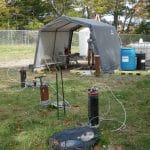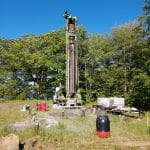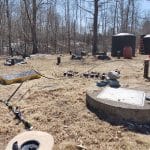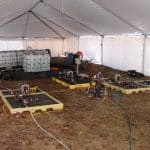Long-term monitoring, groundwater treatment operation & maintenance (O&M), optimization and enhanced in-situ bioremediation (ESIB) to remediate chlorinated solvent contamination in shallow bedrock.
The Eastern Surplus Company Superfund Site is a 5-acre former junkyard bordering Meddybemps Lake and the Denny’s River. Disposal of hazardous wastes at the Site including dense non-aqueous phase liquids (DNAPL) chlorinated solvents that resulted in extensive groundwater contamination in overburden and fractured bedrock. Under CERCLA regulations, Nobis has provided extensive technical support for the remediation of groundwater that has been impacted with perchloroethylene (PCE), trichloroethylene (TCE), dichloroethylene (DCE) and vinyl chloride.
Between 2007 and 2012, Nobis performed long-term response actions, monitoring, O&M of a groundwater extraction system (GWETS) that treated up to 20 gallons per minute (gpm) of impacted water through filtration, carbon treatment and on-site re-injection.
Starting in 2013, Nobis designed and implemented several phases of an anerobic enhanced in-situ bioremediation (EISB) program to reduce source area contamination in overburden and fractured bedrock. This process included the removal of groundwater that was stored on site, adjusted for pH, dissolved oxygen (DO), oxidation reduction potential (ORP) and then amended with emulsified vegetable oil, electron donors, and Dehalococcoides (DHC) bacteria. This mixture was then re-injected back into the aquifer for in-situ treatment and reduction of the chlorinated solvents into ethene and ethane.
challenges
- During the initial months of the groundwater treatment system operation it was realized that system design was creating in-efficient and incomplete treatment of PCE and other chlorinated solvents, potentially related to residual DNAPL in the fractured bedrock treatment zone.
- Long term monitoring and testing of numerous groundwater monitoring wells was extensive and costly.
- After the first 2 treatment/injection events, several of the injection locations experience bio-fouling, such that effective distribution of amendments was not occurring as planned.
solutions
- To address this issue and optimize the remedial treatment approach, Nobis was able to re-design and reconfigure the system treatment train, storage tank configuration and overall flow patterns to eliminate the shut-downs and increase removal efficiency by more than 25%. In addition, Nobis reconfigured the run patterns for two large compressors which decreased the overall energy usage by 35%, while increasing the effectiveness of the removal process.
- Nobis worked with EPA and the Maine Department of Environmental Protection (MEDEP) to remove 35 wells from the long-term monitoring program that were being sampling twice per year.
- Nobis is designing and working with a drilling subcontractor to rehabilitate and clean the impacted wells, such that injection and distribution of amendments can occur more effectively.
results
Over the years, Nobis’ remedial and optimization efforts greatly reduced annual sampling and travel costs, such that savings of more than $750,000 were realized over a period of 10 years, while still maintaining and meeting overall project data quality objectives.
Based on an initial review of the most recent area wide groundwater sampling program, a decrease of more than 40% of the contaminant mass of chlorinated solvents is estimated as a result of the ESIB treatment. As the geochemical and physical conditions are favorable for continued reductive dechlorination, further decreases of contaminant mass are expected.





